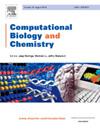探索螺旋环异喹啉-哌啶化合物在结核病治疗中的应用:ADMET分析、对接、DFT、MD模拟和MMGBSA分析
IF 2.6
4区 生物学
Q2 BIOLOGY
引用次数: 0
摘要
由于耐药菌株的存在,结核病仍然是一项全球健康挑战。MmpL3抑制剂已成为有希望的抗结核药物,其临床发展受到微粒体稳定性差的阻碍。本研究计算设计并筛选了40种螺环类似物,并与ICA38和SQ109进行比较。通过计算机分析,包括对接、MD模拟和DFT计算,评估了它们作为抗结核药物的潜力,突出了有希望进一步开发的候选药物。使用Glide软件进行对接研究,发现C21(3,4-二氯衍生物)和C20(5-氯衍生物)是有希望的候选者,其结合分数分别为- 9.79 kcal/mol和- 9.64 kcal/mol。两种化合物均通过氢键与活性位点残基Asp645相互作用,并形成疏水相互作用。DFT结果表明,C21具有较高的偶极矩(3.63 3d)、最优能差(0.18752 eV)、柔软度和硬度(η = 0.09376 eV, σ = 10.666 eV⁻¹)、高电子亲和度(0.02305 eV)、高电负性(0.11681 eV)和高电离势(0.21057 cV)等特征。另一方面,C20表现出与C21相似的电子性质,但存在边际差异。MD模拟显示C21和C20的稳定性(RMSD为2.4 Å和2.2 Å, RMSF <2.5 Å),表明Arg344-Leu354的稳定性有所提高。此外,C21和C20保持Asp645相互作用(91 %,97 %),并表现出与自由能值的强结合(MMGBSA:−72.23,−66.50 kcal/mol)。这些发现突出了化合物C21和C20的效率,具有强的结合亲和力,良好的稳定性和最佳的电子性质,使它们成为进一步开发下一代MmpL3抑制剂的有希望的候选者。本文章由计算机程序翻译,如有差异,请以英文原文为准。
Exploring spirocyclic isoquinoline-piperidine compounds in tuberculosis therapy: ADMET profiling, docking, DFT, MD simulations, and MMGBSA analysis
Tuberculosis remains a global health challenge due to drug-resistant strains. MmpL3 inhibitors have emerged as promising anti-tubercular agents, and their clinical development has been hindered by poor microsomal stability. This study computationally designed and screened 40 spirocyclic analogs, and compared them with ICA38 and SQ109. In silico analyses, including docking, MD simulations, and DFT calculations, were conducted to assess their potential as anti-tubercular agents, highlighting promising candidates for further development. Docking studies using Glide software identified C21 (3,4- dichloro derivative) and C20 (5-chloro derivative) as promising candidates, exhibiting binding scores of −9.79 kcal/mol and −9.64 kcal/mol, respectively. Both compounds interacted with the active site residue Asp645 via hydrogen bonding and also formed a hydrophobic interaction. DFT results revealed that C21 displayed the balanced chemical reactivity, characterized by high dipole moment (3.63D), an optimal energy gap (0.18752 eV), softness and hardness (η = 0.09376 eV, σ = 10.666 eV⁻¹), high electron affinity (0.02305 eV), high electronegativity (0.11681 eV) and high ionization potential (0.21057 cV). On the other hand, C20 exhibited similar electronic properties with marginal differences than C21. MD simulations showed C21 and C20's stability (RMSD 2.4 Å and 2.2 Å, RMSF <2.5 Å), indicating improved Arg344-Leu354 stability. Additionally, C21 and C20 maintained Asp645 interactions (91 %, 97 %) and showed strong binding with free energy values (MMGBSA: −72.23, −66.50 kcal/mol). These findings highlight the efficiency of the compounds C21 and C20 with strong binding affinity, favorable stability, and optimal electronic properties, making them promising candidates for further development of next-generation MmpL3 inhibitors.
求助全文
通过发布文献求助,成功后即可免费获取论文全文。
去求助
来源期刊

Computational Biology and Chemistry
生物-计算机:跨学科应用
CiteScore
6.10
自引率
3.20%
发文量
142
审稿时长
24 days
期刊介绍:
Computational Biology and Chemistry publishes original research papers and review articles in all areas of computational life sciences. High quality research contributions with a major computational component in the areas of nucleic acid and protein sequence research, molecular evolution, molecular genetics (functional genomics and proteomics), theory and practice of either biology-specific or chemical-biology-specific modeling, and structural biology of nucleic acids and proteins are particularly welcome. Exceptionally high quality research work in bioinformatics, systems biology, ecology, computational pharmacology, metabolism, biomedical engineering, epidemiology, and statistical genetics will also be considered.
Given their inherent uncertainty, protein modeling and molecular docking studies should be thoroughly validated. In the absence of experimental results for validation, the use of molecular dynamics simulations along with detailed free energy calculations, for example, should be used as complementary techniques to support the major conclusions. Submissions of premature modeling exercises without additional biological insights will not be considered.
Review articles will generally be commissioned by the editors and should not be submitted to the journal without explicit invitation. However prospective authors are welcome to send a brief (one to three pages) synopsis, which will be evaluated by the editors.
 求助内容:
求助内容: 应助结果提醒方式:
应助结果提醒方式:


